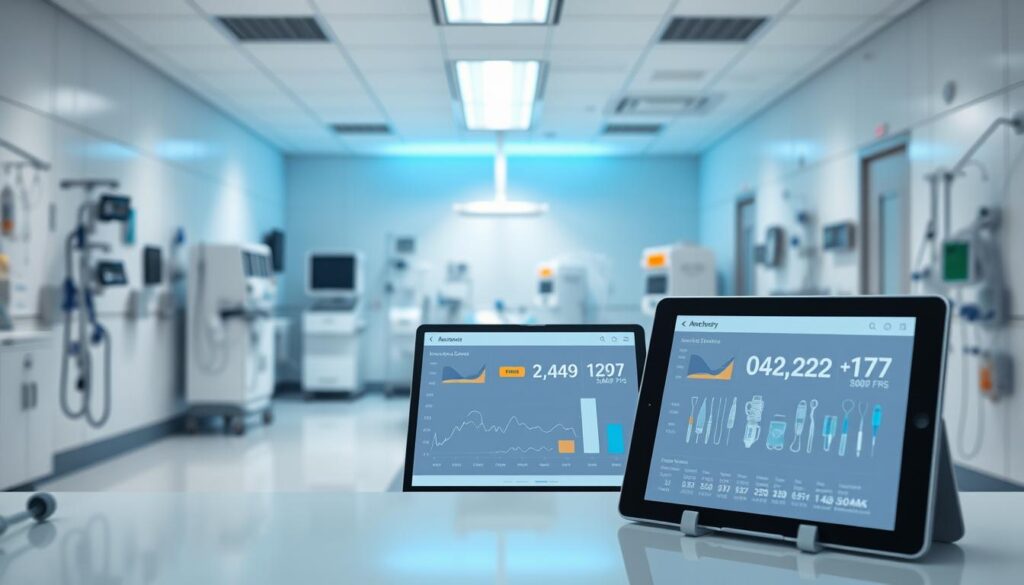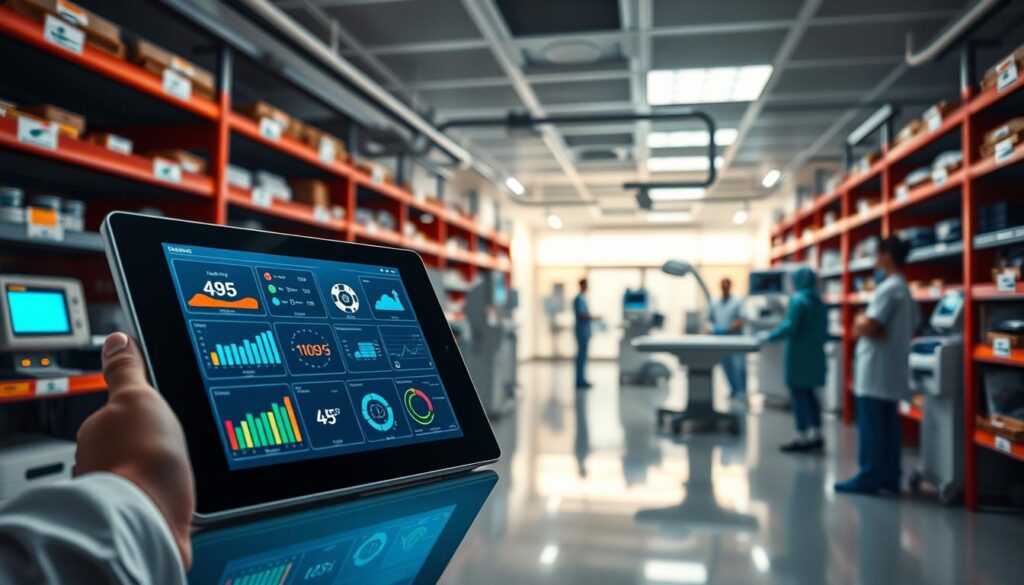A night-shift nurse once spent twenty minutes searching for a vital infusion pump before a scheduled treatment. That delay felt small, but it highlighted a bigger problem: missing devices and slow workflows cost time and can affect care.
Today, connected systems and embedded intelligence turn scattered items into tracked assets. With BLE tags on surgical tools and dashboards that analyze real-time data, teams find gear fast and keep supplies ready for patients.
This guide explains how combining edge analytics and cloud platforms creates operational efficiency across clinical areas. You will see how sensors, analytics, and secure integrations cut search time, reduce waste, and tie supply decisions to treatment pathways.
Iottive’s BLE app and AI-enabled solutions accelerate these programs, helping clinical leaders, supply teams, and IT plan an end-to-end modernization with built-in compliance and resilience.

Key Takeaways
- Connected device tracking reduces time spent locating gear and improves patient care continuity.
- AI-enabled analytics turn raw data into actions like auto-replenishment and staff alerts.
- Edge processing and cloud dashboards together enable faster, smarter decisions.
- measurable gains include fewer expiries, lower stockouts, and better asset utilization.
- Clinical leaders and supply teams can use this guide to plan secure, scalable deployments.
- Iottive provides BLE app development and AIoT integrations to speed implementation.
Understanding the Shift: From Manual Stockrooms to Smart Healthcare Supply Chains
Paper logs and spreadsheet lists used to tell teams what was on the shelf — often too late. Facilities are now moving to connected systems that update supply states as items move, helping staff spend less time searching and more time on patient care.

What “inventory” covers on the floor
Inventory spans infusion pumps, ventilators, handheld ultrasound units, surgical tools, implants, medications, vaccines, blood products, linens, PPE, and spare parts. These items vary by criticality and storage needs, from cold-chain meds to bedside devices.
Why the timing is right
Affordable BLE and RFID, low‑latency edge analytics, and mature cloud platforms make real-time monitoring practical. Live data collection lets teams react instantly to use patterns in the OR, ICU, ED, and pharmacy.
- Clinical impact: devices are available when needed; meds stay within temperature and expiry thresholds.
- Operational shift: periodic counts give way to continuous monitoring and automated replenishment triggers.
- Upstream benefits: improved forecasting, fewer stockouts, and reduced delays for patients.
Security-by-design matters because inventory events touch PHI-adjacent systems. Success also requires workflow integration and staff training. Partners like Iottive translate departmental needs into scalable solutions; contact www.iottive.com | sales@iottive.com.
IoT hospital inventory management: How connected systems transform availability, cost, and care
Connected tags and real‑time dashboards give teams a single view of gear from receiving dock to bedside.
End-to-end visibility and traceability for critical medical devices and supplies
Dock-to-shelf-to-bedside tracking uses BLE and RFID to show what you have, where it is, and its condition. This full-chain view links lot numbers and serials to procedures so recalls and quality checks finish faster.

Reducing stockouts, expiries, and shrinkage with automated alerts
Automated thresholds trigger replenishment and rotate soon‑to‑expire items to high‑use units. Door events, geofencing, and last‑seen timestamps cut shrinkage and misuse of mobile equipment.
Linking inventory to patient care pathways and clinical workflows
Tagging infusion pumps, imaging units, and consumables lets teams reserve equipment for scheduled cases and start sterilization cycles after use.
- Predictive patterns: edge analytics spot abnormal consumption and suggest redistribution.
- Operational alignment: inventory states feed EHR, ERP, and CMMS so biomed and IT prevent cancellations.
- Outcome focus: better availability reduces delays and supports improved patient outcomes.
Iottive implements BLE tags, gateways, and mobile apps and integrates iot solutions with EHR/ERP/CMMS to align supplies with treatment. Contact: www.iottive.com | sales@iottive.com.
How It Works Today: Data flow, devices, and analytics in modern U.S. hospitals
Modern clinical floors stream continuous signals from devices, shelves, and sensors so teams see state changes as they happen.
Data capture and edge processing
Data collection starts at the capture layer: RFID tags on cases, BLE beacons on mobile equipment, smart shelves for meds, and environmental sensors for cold-chain control.
Gateways aggregate those feeds, filter noise, and apply business rules at the edge to cut latency before cloud sync.
Secure transmission and analytics
Encrypted channels, device authentication, and network segmentation protect patient data and supply records. TLS and role-based access enforce policy across healthcare systems.
Analytics run detection models for unusual usage, demand forecasting, and predictive maintenance so teams get actionable insights fast.
Real-time actions and auditability
Automated actions create POs, update par levels, send staff alerts, and post updates to EHR/ERP/CMMS. Bi-directional sync reserves items for scheduled cases.
Immutable logs record who accessed what and when, supporting recalls, billing accuracy, and compliance.
Iottive designs and integrates BLE apps, gateways, and cloud/mobile platforms to secure data transmission and drive automated actions. Contact: www.iottive.com | sales@iottive.com.

Core Technologies Powering Smart Hospitals
A mix of short-range radios, barcode scans, and cellular links lets teams choose the right tool for each task.
Choosing a modality depends on read range, cost, and clinical workflow. Passive RFID suits bulk reads and sterile zones. BLE supports room-level RTLS and mobile workflows. QR codes work for low-frequency audits and low-cost tagging.
RFID vs. BLE vs. QR: choosing by use case and budget
Quick guide:
| Technology | Best use | Range & battery | Typical devices |
|---|---|---|---|
| Passive RFID | Bulk reads, sterile stores | Short, no battery | Supply cases, trays |
| BLE | Room-level RTLS, mobile gear | Meters, battery tags | Infusion pumps, portable scanners |
| QR | Low-cost audits, labels | Line-of-sight, no battery | Consumables, charts |

Scaling and integration
mMTC and 5G RedCap scale thousands of connected devices across sites. Edge nodes run local inference to cut latency for ORs and pharmacies. The cloud then handles long-term analytics and cross-site optimization.
Interoperability essentials
Use FHIR, HL7/REST, and clear data models (UDI, lot, serial) to link EHR, ERP, and CMMS. Secure device identity, rotating credentials, and OTA updates keep systems safe.
Iottive delivers BLE app development, cloud & mobile integration, and custom platforms that tie hardware, firmware, and applications to hospital standards. Contact: www.iottive.com | sales@iottive.com.
Benefits and Business Impact: From operational efficiency to patient outcomes
Real-time tracking and smarter workflows cut search time and streamline tasks. This boosts operational efficiency and lets clinicians spend more time on patient care.
Short wins become lasting gains.
Real-time location tracking of equipment to cut search time and delays
Room-level tracking turns minutes of searching into seconds. Procedure delays drop and staff overtime falls. Healthcare providers see immediate workflow gains.
Predictive replenishment to stabilize critical-care levels
Predictive analytics forecast demand and trigger replenishment before shortages occur. Par levels stay balanced for ICU and ED needs, reducing rush orders.
Cost savings through automation, reduced waste, and fewer readmissions
Automated monitoring prevents expiry losses and protects cold-chain items. That lowers disposal costs and supports safer patient plans, which can reduce readmissions.
![]()
| Benefit | Metric | Typical impact |
|---|---|---|
| Search time | RTLS seconds vs minutes | Procedure delays ↓, overtime ↓ |
| Stock stability | Predictive replenishment | Rush orders ↓, stockouts ↓ |
| Waste reduction | Expiry & cold-chain alerts | Disposals ↓, safety ↑ |
Iottive delivers measurable ROI with solutions that automate tracking and replenishment, integrate with mobile workflows, and improve patient outcomes. Contact: www.iottive.com | sales@iottive.com.
Implementation Roadmap: A practical path to AIoT-enabled inventory
A practical rollout begins with clear baselines for search time, stockouts, and utilization. Start small and prove value before broad deployment.
Assess and prioritize
Focus first on high-value units: OR, ICU, ED, and pharmacy. Measure current search time, expiry rates, and device use to set targets.
Pilot design
Define device choice, gateway placement, and SLAs for accuracy and read rates. Test the full pipeline from capture to secure cloud analytics.
Security and compliance by design
Build security into every step: device provisioning, authentication, encrypted channels, least-privilege access, and audit trails. Ensure HIPAA-aligned controls for patient-adjacent data.
Integration sprints
Map item masters, UDI/lot/serial, locations, and roles across EHR/ERP/CMMS. Use sprint-based API work streams to tie events, orders, and tasks to clinical workflows.
Scale and optimize
Expand unit by unit and tune predictive models, dashboards, and staff training. Schedule firmware updates, battery swaps, and lifecycle steps.
| Phase | Primary goal | Key metric |
|---|---|---|
| Baseline | Measure current state | Search time, stockout rate |
| Pilot | Validate tech & workflows | Read accuracy, clinician satisfaction |
| Integrate | Link to clinical systems | Event sync rate, API latency |
| Scale | Optimize and expand | Reduced expiries, utilization gains |
Iottive runs pilots to production, covering hardware selection, BLE app development, coverage tests, API integration to EHR/ERP/CMMS, and secure cloud/mobile deployment. Contact: www.iottive.com | sales@iottive.com.
Risk, Compliance, and Resilience: Building trustworthy healthcare IoT
Cyber threats now target clinical gear and supply chains, turning availability risks into patient-safety issues.
Cybersecurity threats and safeguards for connected medical environments
Ransomware hit 67% of organizations in 2024, and researchers have shown attacks on insulin pumps and pacemakers. Layered defenses matter.
- Network and endpoint protection: end-to-end encryption, device authentication, and signed firmware.
- Identity and lifecycle: unique device IDs, certificate rotation, secure boot, and patch pipelines.
Data privacy, access controls, and PHI minimization
Minimize patient data in tracking flows, apply role-based access, and log access attempts for anomaly detection. Align designs with HIPAA and audit requirements.
Device management and business continuity
Standardize provisioning, onboarding checklists, and retirement to reduce attack surface. Build offline modes, cellular failover, and prioritized alert escalation.
About Iottive
Iottive embeds security and compliance into BLE apps and end-to-end platforms. We deliver secure provisioning, audits, and incident runbooks so healthcare providers keep devices and data safe. Get in touch: www.iottive.com | sales@iottive.com.
Measuring Success and Looking Ahead
Measuring progress starts with simple questions: are items found faster, and are supply gaps shrinking?
Continuous feeds and clear metrics turn raw data into action. Teams should set baselines, then track how fast they can locate gear and how often stockouts occur.
KPIs that matter
Define baseline and targets for search time, stockout percentage, expired-item value, and turnaround time for replenishment.
Then add advanced metrics: utilization by unit, shrinkage rate, cold-chain excursions, and forecast accuracy versus actual consumption.
From insights to action
Use dashboards and real-time data to tie analytics to staffing, purchasing, and clinical quality. Visualize role-based views for nursing, pharmacy, and materials so teams can drill down to item, lot, or room.
Close the loop by converting insights to automated actions—PO creation, task assignments, and redistribution between units. Evaluate clinical impact by correlating on-time procedure starts with improved patient outcomes.
Iottive delivers dashboards and analytics that translate usage data into actions for supply chain, clinical ops, and finance. Contact: www.iottive.com | sales@iottive.com.
Conclusion
When systems and staff share timely data, delays shrink and care teams act faster. Connected platforms align operations with clinical needs so the right devices and supplies reach the bedside when patients need them.
Measurable wins include faster searches, fewer stockouts and expiries, stable par levels, and smoother surgical starts. Enablers are interoperable systems, edge analytics, reliable wireless (including 5G/RedCap), and sensors that feed secure data streams.
Security, privacy, and lifecycle controls keep trust and continuity. Start by assessing high-value departments, run a focused pilot with clear KPIs, and scale with governance and staff training.
Partner with Iottive to design, integrate, and operate tailored iot solutions that tie devices, analytics, and workflows to patient-first care. Schedule a consultation at www.iottive.com or email sales@iottive.com.
FAQ
What does “inventory” cover in a medical setting?
In a clinical environment, inventory includes medical devices (infusion pumps, monitors), medications, single‑use consumables (syringes, gowns), spare parts, and supporting supplies. These items support clinical workflows across the OR, ICU, ED, pharmacy, and outpatient units. Clear classification helps prioritize tracking, replenishment, and regulatory controls.
Why is the shift to connected supply chains happening now?
Advances in low‑power wireless sensors, widespread cellular and Wi‑Fi coverage, and affordable edge analytics let facilities gather real‑time data at scale. Combined with cloud platforms and machine learning, hospitals can predict demand, reduce waste, and link stock to patient care pathways—driving faster ROI than decades‑old manual systems.
How do real‑time location systems improve clinical availability?
Real‑time tracking removes wasted search time by pinpointing equipment and high‑use consumables. That reduces procedure delays, shortens turnover, and improves staff productivity. When devices are tagged and visible, clinicians spend less time hunting gear and more time on patient care.
Which tracking technologies are used, and how do you choose among them?
Common modalities include passive RFID for bulk reads, BLE beacons for room‑level location, and QR/barcodes for item‑level verification. Selection depends on range needs, cost, read frequency, and accuracy. For example, sterile trays may use RFID, while carts and expensive pumps often use BLE or active tags.
How does predictive replenishment reduce expiries and stockouts?
Predictive models analyze historical consumption, case schedules, and lead times to forecast demand. Systems trigger automated purchase orders or replenishment when thresholds approach, preventing expiries and shortages. This stabilizes critical‑care inventories and reduces waste and emergency sourcing costs.
What data sources feed analytics platforms in modern systems?
Platforms aggregate tag reads, sensor telemetry (temperature/humidity), EHR procedure logs, purchasing records, and CMMS maintenance data. Combining these sources enables anomaly detection, demand forecasting, and automated workflows that reflect both clinical and operational realities.
How are systems integrated with EHR, ERP, and maintenance tools?
Integration uses APIs, HL7/FHIR interfaces, and middleware to map item identifiers, transaction types, and location hierarchies. Tight mapping ensures inventory events update patient records, billing, and maintenance tickets in near real time, eliminating double entry and reconciliation delays.
What cybersecurity and privacy safeguards are required?
Secure deployments use device authentication, encrypted communications, network segmentation, and role‑based access controls. PHI minimization, audit logging, and compliance with HIPAA standards are essential. Regular patching and vulnerability management for connected devices reduce exposure.
How do hospitals ensure resilience and business continuity?
Resilience measures include local edge processing to maintain core functions offline, redundant gateways, automatic failover for cloud services, and escalation paths for manual overrides. These steps keep critical alerts and location services functioning during outages.
What KPIs should organizations track to measure success?
Focus on search time reduction, stockout rate, expiry waste percentage, time‑to‑replenish (TTR), and inventory carrying costs. Clinical metrics like on‑time case starts and reduced procedure delays tie operational gains to patient outcomes and ROI.
Which departments should be prioritized for pilots?
Start with high‑value, high‑impact areas: operating rooms, intensive care units, emergency departments, and central pharmacies. These zones have concentrated asset use, clear workflows, and measurable outcomes, making them ideal for demonstrating value.
How do edge analytics and cloud services work together?
Edge nodes handle low‑latency tasks—real‑time location, basic anomaly detection, and local alerts—while cloud analytics run heavier models for demand forecasting, historical reporting, and cross‑facility optimization. This split reduces bandwidth, improves responsiveness, and preserves data privacy.
What role does mobile access play for clinical staff?
Mobile apps provide on‑demand location searches, replenishment requests, and alerts at the point of care. Simple interfaces reduce friction for nurses and techs, speeding task completion and improving adherence to stock protocols.
How is device lifecycle and patch management handled at scale?
Centralized device management platforms provision credentials, track firmware versions, schedule patches, and manage decommissioning. Automated workflows and audit trails help maintain compliance and reduce the risk of unsupported devices in clinical use.
What are common barriers to adoption and how can they be overcome?
Barriers include legacy system integration, staff change resistance, and budget constraints. Address them with phased pilots, clear success metrics, executive sponsorship, and hands‑on staff training. Demonstrating fast wins in high‑impact areas builds momentum.
How do temperature and condition sensors protect sensitive supplies?
Continuous temperature and humidity monitoring with alerting prevents cold‑chain breaches for vaccines and biologics. Automated logs support compliance and batch investigations, reducing spoilage and regulatory risk.
Can these systems support multi‑facility networks and scaling?
Yes. Modern architectures use standardized APIs, cloud orchestration, and device provisioning to scale across campuses. Network planning for mMTC and 5G/RedCap options ensures reliable connectivity for thousands of connected devices.
How do analytics link inventory to patient outcomes?
By correlating supplies used per procedure, timing of availability, and readmission or delay metrics, analytics identify supply‑driven care gaps. That insight informs staffing, purchasing, and clinical pathways to improve outcomes and reduce avoidable harm.
What should a success criteria set include for a pilot?
Define targets for search time reduction, stockout decreases, expiry waste reduction, user adoption rates, and integration accuracy with EHR/ERP. Measurable financial and clinical KPIs help justify broader rollouts.
How are alerts and escalations managed to avoid alarm fatigue?
Configure tiered alerting with actionable thresholds, role‑based routing, and smart suppression during known events. Integrate with staff schedules and on‑call rosters so notifications reach the right person at the right time.
Where can providers find vendors and solution partners?
Evaluate vendors that demonstrate interoperability with major EHRs, strong security practices, and proven deployments in ORs, ICUs, and pharmacies. Look for partners offering end‑to‑end services: sensors, middleware, analytics, and implementation support.